THUKRAL AND TAGRA: MATCH FIXED
| March 25, 2011 | Post In LEAP 7

For their Beijing debut, the Indian duo of Thukral & Tagra transformed the UCCA’s middle hall into a spectacle in their signature style of “Punjabi Baroque.” With white retro furniture, warm family photos, glass crystal ornaments, and cheap kitschy artificial flowers meticulously arranged; red safflowers blooming against a blue wall-paper background; Kabbadi (a form of Indian falconry), accompanied by the heroic silhouettes of trophies. The artists tie everything together with a set of indomitably huge pink drapes. Here is a happy Western life as seen through Eastern eyes.
Thukral & Tagra come from Punjab in northern India, where families with girls hope to marry their daughters off to the citizens of developed Western countries. Though unclear as to the background of the incipient husband, families go bankrupt trying to satisfy his demands, pulling out all of the stops “in the interest of marriage.” The ultimate outcome is often very far from the happy life the naïve girls wish for in their hearts, and they are left to face abandonment, the tragic lot of outcasts. In the gallery, women of various ages recount their experiences before the camera. Some wear veils concealing everything but pairs of deep, beautiful eyes brimming with grief and resentment. Some are poised and cool, their expressions calm as though recounting someone else’s story. Some suppress anger as they denounce their husbands’ families for their cruelty or their own families for their mercilessness. Some hold their gazes firm, the space between each word emanating faith in a brighter future—but for all of these women, the tireless murmurs of their voices reveal the vulnerable position of women in an overwhelmingly patriarchal society. In addition, Thukral & Tagra have placed the smiling profiles of the men and women featured in these narratives, together with mounted reflective glass, into white picture frames that represent airplane windows. As audience members pass by, they inadvertently fall into the artists’ “trap,” projecting themselves into their subjects’ stories.
“Offense” and “defense” are not only the principles of Kabbadi, but also the rules established between individuals in modern society. So-called “covenant marriages” are part of a global phenomenon stemming from problems of faith, human rights, and ethnic and cultural realities born out of economic and ideological gaps between developed nations and Third World countries. These factors develop the rules of the game, and in turn produce a host of tragic individual fates. The artistic effect of “Match Fixed” is one both fantastical and tongue-incheek; as it sharply satirizes Indian society, this installation—like Thukral & Tagra’s past works— takes a light approach in presenting heavier subjects such as globalization, consumerism, traditional heritage, and cultural identity.
“Match Fixed” opened at the UCCA on the same day as “Hometown Boy,” the solo exhibition of China’s celebrated “neorealist” painter Liu Xiaodong. Both exhibitions explore the state of society in underdeveloped areas of developing nations, and they both provide mild-mannered packaging for cold and cruel realities; putting the two together was perhaps intentional on the part of the curators. Judging by its reception, “Match Fixed” is evidently no match for “Hometown Boy.” Having withstood the test of time, Liu Xiaodong has once again accessed the timeless within the present: standing before his works, a Chinese audience cannot help but be shaken and directly moved. In contrast, due to a lack of understanding of Indian contemporary art at large, the audience has trouble fully understanding “Match Fixed,” and finds itself viewing the work from a topdown perspective, while at the same time eager to understand its significance—thereby weakening its expressive force, and making it difficult to pause and truly savor. Jin Simeng

